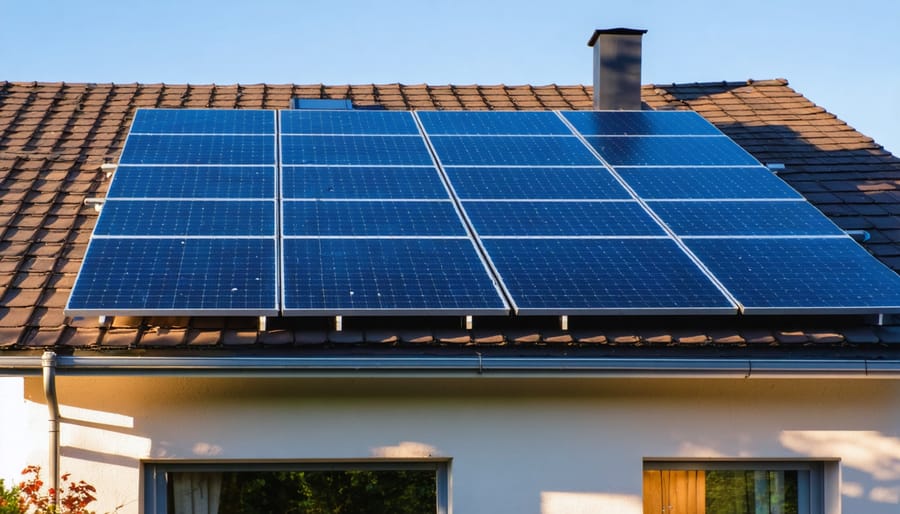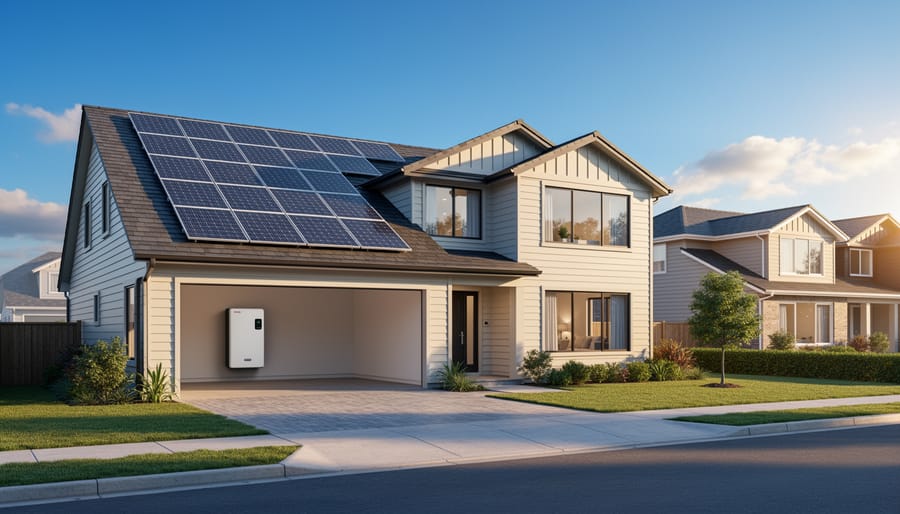A Complete Guide on Disconnecting Solar Panels
Updated:

Disconnecting your solar panels may sound pretty simple and straightforward. Unfortunately, this is not really the case, and getting it wrong can have dire consequences. Many folks don’t realize that there are several “active” or “live” components in any solar system, particularly a hybrid solar system.
This makes applying correct safety precautions when disconnecting a solar panel or panel array essential. This is particularly true with roof-mounted panels, where an electric shock is often accompanied by a serious fall.
Solar Panel Components and Disconnection Points
If you have a home solar power system, you will probably have to disconnect the solar panels at some point. This will typically be done for maintenance or moving the array. If you are grid-tied with a hybrid solar system, you’ll need to isolate the AC circuit as well. This is because hybrid solar systems are integrally connected to the mains AC grid.
Domestic solar panels will generally be fitted with a junction box on the back of the panel. The output cables connect to the panel in this box and are usually terminated with MC4 IP67 type connectors. This setup is pictured below in Fig. 1, and with it, an average solar panel system is illustrated in Fig2.


This is, however, not always the case. Depending on how the solar installation was done and by who, you may have a very different layout. These may range from really functional and easy to use to the stuff of National Fire Protection Association nightmares. At least when it comes to disconnecting your solar panels.
We’ll detail the most common scenarios you may encounter and how to disconnect the solar panels safely in each case.
Safety First and Foremost!
Although solar system outputs prior to leaving an inverter are low voltage, caution and safety are still paramount. Before attempting to disconnect the solar panels, isolate all AC or DC disconnect switches or fuses in the circuit. Try to make the disconnection at dusk, if at all possible when the panel output is low. If this is not feasible, cover the solar panel with a dense, dark-colored cloth or blanket.
In addition, it is good practice to disconnect the solar panel leads from the charge controller if one is installed. It also wouldn’t hurt to disconnect the charge controller, inverter, and utility meter as well.This just removes all chances of a mishap and makes for peace of mind.
And remember your PPE (personal protective equipment). These items include basics such as safety glasses and insulated gloves. When working at heights such as on a ladder or roof, a safety harness and hard hat are essential.
The Conventional Scenario
This type of installation includes standard MC4 connectors on the panel output leads as illustrated above in Fig. 1. A typical, complete solar home circuit, including MC4 connectors, is illustrated in Fig 2. Having MC4 connectors fitted to the panel cables is great and should ideally be a standard feature.
Fig. 2 illustrates a solar power circuit without panel isolation circuit breakers. This is typical of a conventional solar installation that would be most commonly encountered. Having MC4 connectors in the circuit makes things safer and easier, even if there are no isolation breakers though.
Making the Disconnection
To disconnect solar panels in this type of installation, first, cover the solar panel. Then use a multimeter to check the voltage on the charge controller solar panel connections. The voltage reading should be zero or be very close to it.
If this is so, you can simply unplug both MC4 connectors. Here is a quick video tutorial on doing this. They are fully insulated and if you are wearing insulated gloves, this is a safe operation.
https://www.youtube.com/watch?v=23iuR9HTYYA
Just remember to cover the solar panel if you are working during daylight hours as mentioned above and to isolate the consumer circuit breaker.
The panel or solar panels are now disconnected and you can proceed with whatever work you need to do on the PV system.
The Best-case Scenario
The best situation includes MC4 connectors and an isolation breaker between the panel and the rest of the circuit. This is illustrated below in Fig 2a. In this situation, things are safe and simple.
To disconnect the panel or panels via the MC4 connectors, follow these simple steps:
- Cover the panel
- Pull the solar source fuses, or switch both the AC and DC disconnect switch (circuit breaker) off
- Disconnect the MC4 connectors.

The Worst-case Scenario
This is when your solar panels are wired directly into the circuit with no MC4 connectors, fuses, or disconnect switch. Normally, this will be the exception rather than the rule, but it can happen nevertheless. This is illustrated below in Fig. 3.

This will require physical disconnection of the panels from the charge controller while the panel is “live”. Again, switch the disconnect switch or circuit breakers on the high voltage consumer side of the solar circuit off before you proceed.
Cover the panel and disconnect the battery cables. Check the panel voltage as detailed above, then remove the panel leads from the charge controller. Now the solar panels are fully disconnected and out of the circuit.
Important Considerations When Disconnecting Active Solar Panels
Safely disconnecting solar panels is one thing. There are other important points that you have to keep in mind if you chose to do this though.
How Long Can you Leave Solar Panels Disconnected?
Disconnected solar panels left in situ on the roof of an RV or house PV system are still live. They may not be feeding power to the rest of the solar system, but they are still generating power. The same applies to a portable solar system. Having no load on the panels, i.e. nowhere for that power to go, is not a healthy situation. Especially when the panels are left disconnected for long periods.
How Long Is too Long?
Typically, leaving solar panels disconnected for 2 up to a maximum of 3 days should be ok. Longer than that and you run the risk of overloading the panel and damaging it. This is where a panel cover is indispensable.
They keep the panel isolated from sunlight and prevent it from producing power. Unfortunately, they tend to trap a lot of heat around the panel. So, again, keep the disconnection period as short as possible.
Using Solar Panel Covers
Sometimes new solar panels ship with protective covers, but mostly they don’t. This will leave it up to you to buy or make your own custom covers. And having a set is certainly worth the expense and effort, particularly when you disconnect solar panels.
Considering the benefits of having a set on hand, they seem to be pretty scarce. There are some suppliers, but they are few and far between. This will leave their production up to you in most cases.
The best material to use to make up a set of covers for solar panels is dense, heavy, and durable. An ideal choice is the Sunbrella range of cover fabrics. Particularly their range of heavy-duty marine products. These materials are specifically designed for harsh environments and make ideal covers for solar panels.
Isolating Your Solar PV System
As you have probably seen, having a comprehensive installation makes for ease of repairs or maintenance. And the inclusion of circuit breakers in the system makes for that comprehensive nature.
Circuit Breakers in Solar Systems
Active power supply components in a solar system should always be considered to be just that – active. They can still carry power even if other components are disconnected and removed. For example, even if you disconnect the solar panels, the charge controller can still have power on it from the battery. As can the inverter.
This is the reason it is a good practice to include circuit breakers or sets of fuses in the circuit. Ideally, there should be two disconnect points. One between the solar panels and one between the battery and the inverter. The positions of these circuit breakers can be seen in Fig. 2a above.
Fuses in Solar Power Systems
Fuses work just as well as circuit breakers to safely disconnect solar panels. These can either be convention-type fuses or inline types. Inline fuses may be of the “blow and replace” type, or be reset types.
As a matter of fact, there are several very useful fuses on the market designed specifically for solar power systems. Similar in design to a conventional MC4 connector, these inline components can double as a fuse and disconnector.
Why Is This Important?
Having these elements in a solar PV system is helpful because it effectively breaks the circuit into 3 distinct parts. And it does it at points that isolate the parts of the system that are most likely to be the source of electric shocks or burns.
Having these isolation points in place allows you to work on all the major components in the system safely. And when you have to disconnect solar panels, it makes the job a lot safer. If fact, it would be a good idea to specify the inclusion of these elements when having a system installed. Many installers don’t include separate CBs or fuses, so insist on having them included in your system.
In Conclusion
Having to disconnect your solar system panels is something you can realistically expect to do at some point. Hopefully, this article will help make the process a little easier and safer for you.








